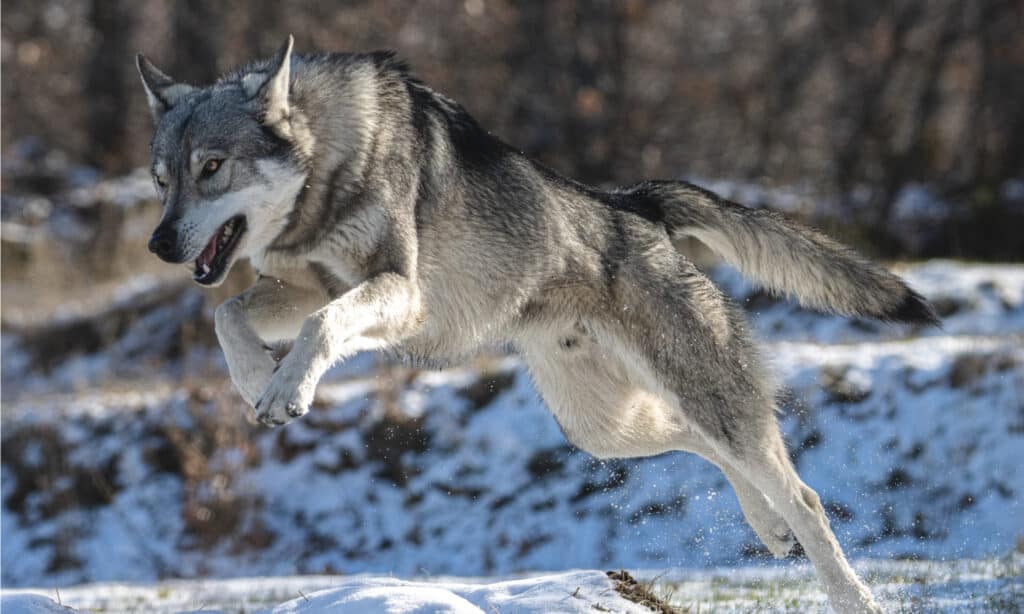On average, wolves’ top running speed reaches up to 45 mph (miles per hour)! They cover up to 16 feet in a single bound, too. Wolves not only run fast but can maintain these top speeds for at least 20 minutes while hunting. However, these incredible canines are better known for their endurance than their speed.
Wolves have to be fast in order to catch their prey. These fascinating canines prey on animals such as deer, elk, rabbits, and even mice. Most of the time, they hunt with the pack (family group) and use pack-hunting strategies to bring down larger prey. The pack also works together to defend themselves and their meals from larger predators like bears.
Let’s learn more about these amazing creatures’ capabilities below!
How Far Can a Wolf Run Without Stopping?
Wolves don’t run most of the time. They typically move along at a speed of about 5 mph. At this leisurely pace, they may cover as many as 30 miles in a single day. Wolves normally travel with their pack, but alpha (dominant or leading) pack members may circle back to round up stragglers or lost pups. They also howl to signal to their pack members and other packs in the area.
Although the typical territory of a single wolf pack is about 50 mi² (square miles), they extend up to 1000 mi² when prey is scarce. The pack must spend time marking their borders and protecting them from rival wolf packs and other animals. Fights between wolf packs are rare, but they will viciously defend their territory should the need arise. This is especially true when the pack has cubs to care for.

Wolves are very athletic with the ability to jump at least 16 feet in one bound.
©iStock.com/Michel VIARD
What Makes Wolves So Enduring?

These canines have incredible endurance.
©Sergijimenez/Shutterstock.com
Wolves rank number seventh on the top 10 list of animals with the best endurance worldwide. We learned that the wolf can run at high speeds for long periods and travel at low speeds for extreme distances. However, what gives them this amazing endurance?
The wolf’s body composition largely contributes to its endurance. They have a deep, narrow chest and splayed front legs. This allows their rear feet to follow the same path as their front feet. This way, they cover ground more efficiently. Their deep chest houses massive lungs that allow air to pass in and out more easily and keep the body well-oxygenated. Muscles need oxygenated blood to function properly.
Wolves also have powerful back and leg muscles along with a strong and stable bone structure. These features essentially allow wolves to push off from the ground with explosive strength. In fact, they’ve been known to jump over 6-foot-tall fences! Now, they can’t jump clear over. They take a running leap and grab the top of the fence with their front legs to pull themselves over. A wolf is strong enough to clear at least a 3-foot-tall fence with ease, even with medium-sized prey in their mouth.
Wolves also have large, wide feet with thick padding which allow them to spread their weight out over soft ground like mud, sand, and snow. This feature makes traveling in the conditions much easier for the wolves because they don’t sink when they run. The padding also gives them a good grip on uneven surfaces like rocks and fallen trees.
Are Wolves Faster Than Humans?

Absolutely. The fastest human ever in the world ran 27.5 mph in a dead sprint. The average human barely runs up to 10 mph. Wolves easily run up to 45 mph, reaching that top speed in just a few seconds. An unarmed human vs. wolf fight would surely see the canine win without much contest.
Wolves are dangerous to humans if they choose to attack, but attacks on humans are incredibly rare since they tend to flee rather than fight. However, they will fight if threatened, teased, or cornered.
Not only are they fast runners, but wolves have long, sharp teeth designed for grabbing onto prey and killing it. They easily rip and tear flesh and crunch through bones. A wolf’s bite force is about 400-1500 psi (pounds per square inch), which is 2–5 times that of a typical German shepherd dog. Sources vary regarding their bite strength, but even at the low end, they can crush bones. Actually, these strong canines produce enough force to bite through a moose femur! Chewing into bones provides them access to the fat-rich marrow inside. They also contain essential nutrients such as phosphorus and calcium. This is especially useful during long winters when food is hard to come by. Eating bones also helps clean their teeth.
The photo featured at the top of this post is © Warren Metcalf/Shutterstock.com
Thank you for reading! Have some feedback for us? Contact the AZ Animals editorial team.







